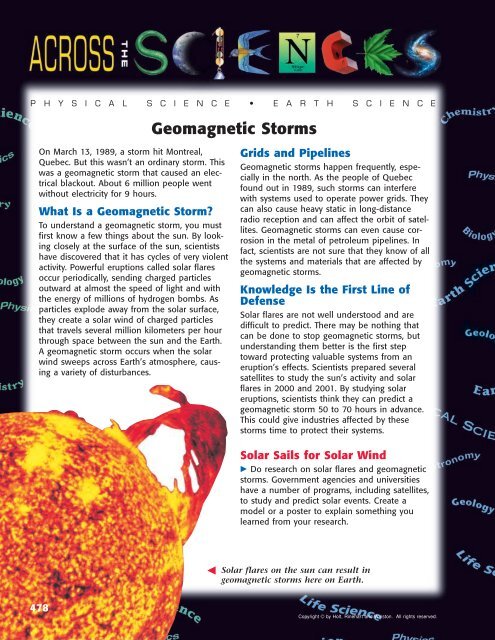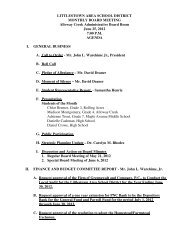Electromagnetism Electromagnetism
Electromagnetism Electromagnetism
Electromagnetism Electromagnetism
Create successful ePaper yourself
Turn your PDF publications into a flip-book with our unique Google optimized e-Paper software.
P H Y S I C A L S C I E N C E • E A R T H S C I E N C E<br />
On March 13, 1989, a storm hit Montreal,<br />
Quebec. But this wasn’t an ordinary storm. This<br />
was a geomagnetic storm that caused an electrical<br />
blackout. About 6 million people went<br />
without electricity for 9 hours.<br />
What Is a Geomagnetic Storm?<br />
To understand a geomagnetic storm, you must<br />
first know a few things about the sun. By looking<br />
closely at the surface of the sun, scientists<br />
have discovered that it has cycles of very violent<br />
activity. Powerful eruptions called solar flares<br />
occur periodically, sending charged particles<br />
outward at almost the speed of light and with<br />
the energy of millions of hydrogen bombs. As<br />
particles explode away from the solar surface,<br />
they create a solar wind of charged particles<br />
that travels several million kilometers per hour<br />
through space between the sun and the Earth.<br />
A geomagnetic storm occurs when the solar<br />
wind sweeps across Earth’s atmosphere, causing<br />
a variety of disturbances.<br />
478<br />
Geomagnetic Storms<br />
Grids and Pipelines<br />
Geomagnetic storms happen frequently, especially<br />
in the north. As the people of Quebec<br />
found out in 1989, such storms can interfere<br />
with systems used to operate power grids. They<br />
can also cause heavy static in long-distance<br />
radio reception and can affect the orbit of satellites.<br />
Geomagnetic storms can even cause corrosion<br />
in the metal of petroleum pipelines. In<br />
fact, scientists are not sure that they know of all<br />
the systems and materials that are affected by<br />
geomagnetic storms.<br />
Knowledge Is the First Line of<br />
Defense<br />
Solar flares are not well understood and are<br />
difficult to predict. There may be nothing that<br />
can be done to stop geomagnetic storms, but<br />
understanding them better is the first step<br />
toward protecting valuable systems from an<br />
eruption’s effects. Scientists prepared several<br />
satellites to study the sun’s activity and solar<br />
flares in 2000 and 2001. By studying solar<br />
eruptions, scientists think they can predict a<br />
geomagnetic storm 50 to 70 hours in advance.<br />
This could give industries affected by these<br />
storms time to protect their systems.<br />
Solar Sails for Solar Wind<br />
Do research on solar flares and geomagnetic<br />
storms. Government agencies and universities<br />
have a number of programs, including satellites,<br />
to study and predict solar events. Create a<br />
model or a poster to explain something you<br />
learned from your research.<br />
Solar flares on the sun can result in<br />
geomagnetic storms here on Earth.<br />
Copyright © by Holt, Rinehart and Winston. All rights reserved.





